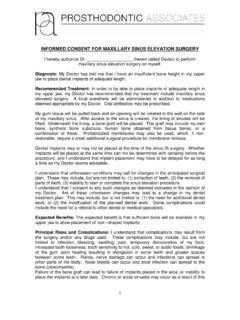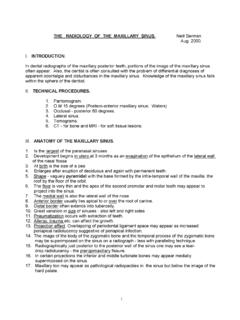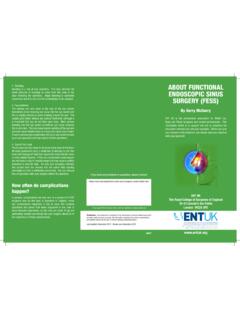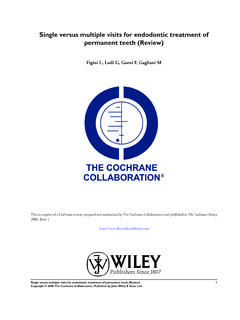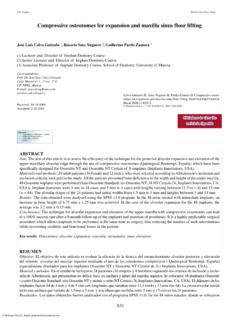Transcription of PDA, ASD, VSD - amcresidents.com
1 PDA, ASD, VSD Reference: Anesthesia for Congenital Heart Disease Authors: Andropoulos, D., Stayer, S. and Russell, I. Blackwell, 2005 Patent Ductus Arteriosus The ductus arteriosus is an essential component in normal fetal circulation; it becomes functionally closed within 10-15 hours after birth, and permanently closes by thrombosis, intimal proliferation, and fibrosis in the first 2-3 weeks after birth. Functional closure is initiated by several mechanisms including aeration of the lungs, removal of prostaglandins produced in the placenta, increased arterial P02 and release of vasoactive substances (bradykinin, thromboxanes, and endogenous catecholamines).5-7 Isolated persistent patent ductus arteriosus (PDA) occurs in approximately 1 : 2500 to 1 : 5000 live births, the incidence is higher for premature births and this defect is two to three times more common in females than in ,8 PDA is also found as part of other complex congenital heart defects and is usually the source for pulmonary or systemic blood flow in patients with a functional single ventricle before palliative repair.
2 Anatomy Embrylogically, the ductus arteriosus arises from the distal portion of one of the sixth paired aortic The PDA is a vascular communication between the descending aorta and pulmonary artery. The PDA most commonly arises from the aorta, just distal to the left subclavian artery and attaches to the left pulmonary artery (Fig. ). 1 Fig. Patent ductus arteriosus. Reproduced with permission from Cooley DA, Norman Jc. Closure of patent ductus arteriosus. In: Cooley DA, Norman Jc. Techniques in Cardiac Surgery. Houston, TX: Texas Medical Press, 1975: 10-17. Pathophysiology and natural history The degree of left-to-right shunting depends on several factors, the actual dimensions of the shunt as well as the relative ratio of PVR and SVR. The shunt dimensions of importance include the diameter and length of the PDA; shorter connections with larger diameters produce less resistance, allow greater flow.
3 In patients with large PDAs, the diastolic runoff into the pulmonary artery results in lowered aortic diastolic pressure, which may increase the risk of myocardial ischemia, especially in the presence of anemia or lowered The consequences of a PDA left untreated depend on many factors. A small PDA may be hemodynamically insignificant and unrecognized. The larger the PDA or left-to-right shunt, the more likely the progression to CHF, pulmonary hypertension, and in extreme cases, reversal of the shunt. In premature infants, PDA is associated with increased morbidity from associated respiratory distress syndrome, necrotizing entercolitis, and intracranial hemorrhage. Surgical approaches In newborns, surgical treatment is usually reserved for patients who fail medical treatment with indomethacin. The usual surgical options include posterolateral thoracotomy with ligation or division of the PDA or video-assisted thoracoscopic surgery (VATS).
4 Surgical approaches have mortality approaching 0% and minimum morbidity; however, mortality rates in premature neonates is slightly Complications of surgical treatment include, bleeding, chylothorax, vocal cord paralysis (injury to recurrent laryngeal nerve), pneumothorax, atelectasis, recurrence of patency, and inadvertent ligation of the pulmonary artery or descending Patent ductus arteriosus Aorta Video-assisted thoracoscopic surgery has increasing popularity due to decreased pain, decreased hospital cost (secondary to decreased hospital stay), and avoidance of post-thoracotomy syndrome (rib fusion, chest wall deformities, scoliosis, and compromise of pulmonary function). Disadvantages of VATS include intraoperative desaturations and hypercarbia, as well as higher morbidity during the surgicallearning Transcatheter closure techniques Many catheter methods have been developed to nonsurgically close a PDA and include the Gianturco coils, the Gianturco-Grifka coil bag and the Amplatzer duct occluder (not Food and Drug Administration [FDA] approved).
5 8,12,13 These methods are considered safe, efficacious, and cost effective when compared to surgical closure. Risks of transcatheter approaches include arrhythmias, embolization of the device, and incomplete In addition, there are size limitations in small infants. Anesthetic considerations The anesthetic management for PDA ligation depends upon factors such as patient's clinical condition, prematurity, coexisting disease, body weight, and surgical technique. Standard ASA monitors are used, along with pulse oximetry of both upper and lower extremities which will assist in detecting inadvertent ligation of the descending aorta. In addition, placing a non-invasive blood pressure cuff on both upper and lower extremites will assist in determining if the PDA ligation produced some degree of coarctation of the aorta.
6 Large volume venous access (which may be a 22 or 24 gauge Lv. in a premature infant) and forced air-warming devices are also recommended. Among patients with coexisting disease, intra-arterial pressure monitoring provides a method of assessing arterial blood gases, electrolytes, hematocrit, and acid-base status. Neonatal patients commonly develop hemodynamic instability from exposure to inhaled anesthetics and benefit from an intravenous anesthetic technique using opioids such as fentanyl and possibly a benzodiazepine along with muscle relaxation. Fentanyl-based anesthesia reduces the neonatal stress response and improves postoperative outcome. 15 Neonatal PDA ligation is often performed in the newborn intensive care unit to avoid the additional risks of transport, need for ventilator changes, and hypothermic exposure.
7 High spinal anesthesia, caudal and thoracic epidural techniques have all been described as safe and producing faster Lung isolation improves surgical exposure, especially for VATS surgical techniques, but may require ventilation with 100% inspired oxygen to maintain acceptable oxygenation. Prior to lung isolation, efforts should be used to limit the degree of left-to-right shunting by maintaining or improving pulmonary vascular tone: minimize the FIO2 and maintain PaCO2 between 40 and 50. Atrial Septal Defects The right and left atria are normally divided from fusion of two septa, the septum primum and the septum secundum. The septum primum develops during the fourth week and the septum secundum develops during the fifth week of The septum secundum forms an incomplete partition and leaves an opening called the foramen ovale.
8 The septum primum becomes the valve of the foramen ovale. 5 Five different types of atrial septal defects exist: (i) secundum; (ii) primum; (iii) sinus venosus;. (iv) patent foramen ovale (PFO); and (v) coronary sinus (Fig. ). Isolated ASDs are more common in females than males by a factor of 2 : 1. Atrial septal defects make up approximately 5-10% of all congenital heart defects with the secundum ASD comprising nearly 80% of A probe patent foramen ovale (PFO) is found in approximately 30% of normal adult hearts. Atrial septal defect may be isolated or associated with other congenital heart defects, where it may be a life saving communication allowing mixing of blood between the pulmonary and systemic circulations, such as total anomalous pulmonary venous return (TAPVR), tricuspid atresia, and transposition of the great arteries 3gery. Houston, TX: Texas edical Press, 1975: 70-9.
9 Fig. Composite of major types of atrial septal defect. See text for explanation. Reproduced with permission from Cooley DA, Norman Jc. Closure of atrial septal defect. In: Cooley DA. Norman JC. Techniques in Cardiac SurM Anatomy Secundum atrial septal defect The secundum ASD is contained within the area bordered by the limbus of the fossa It results from an abnormal reabsorption of the septum primum or defective formation or shortening of the septum secundum. Combinations of these abnormalities may contribute to large defects. Primum atrial septal defect The primum ASD results from abnormalities in formation of the septum primum. It is frequently associated with atrioventricular canal (A VC) defects, especially the partial atrioventricular canal (P A VC) that includes a cleft in the anterior leaflet of the left atrioventricular valve.
10 These A VC defects are due to defects in fusion of the endocardial cushions. sinus venosus atrial septal defect sinus venosus defects result from abnormal development of the septum secundum or the sinus venosus, the primitive venous collecting chamber. The most common type is located near the superior vena cava (SVC) orifice and is associated with partial anomalous pulmonary venous return (PAPVR) involving the right upper and middle pulmonary veins. Defects near the orifice of the inferior vena cava also exist and may involve PAPVR of the right lower pulmonary vein. Patent foramen ovale Patent foramen ovale results from failure of fusion of the septum primum to the limbus of the septum secundum. Patent foramen ovale is normal during fetal life as blood passes from right to left bypassing the lungs in fetal circulation.
